[NS24] Molecular Mechanisms of Learning and Memory
이전까지는 어디에 memory와 같은 정보가 저장되었는지를 초점을 두고 봤다면,
이제는 그만큼 중요한 어떻게 그것이 저장되는가? 라는 질문에 대해 답을 할 때이다.
무척추동물은 기억이 어떻게 이루어지는지를 실험하기 위해 좋은 대상이다. 큰 뉴런으로 이루어진 작은 신경계를 가지고, 뉴런 연결이 알려져있고 재생산가능하며, 단순한 유전 현상을 일으키기 때문이다.
Eric R. Kandel이라는 분은 이걸 Aplysia라는 무척추동물을 가지고 실험을 해서 Hebb의 주장이 맞음을 보였다;
Memory can reside in synaptic alterations.
막 요즘은 activity-dependent synaptic plasticity and memory formation이 발달기때의 그것과 매우 유사하다는 재미있는 결과도 보였다.
이런 physical basis of learning and memory는 psycology부터 molecular biology등 여러 곳에 이득을 주어왔고, 이 장에서는 그런 몇몇 발견들을 살펴보기로 하자.
1. Memory Acquisition
Learning and memory가 2개 단계로 일어난다고 고려하는 것이 쓸모가 많다:
- Acquisition of a short-term memory
- Consolidation of a long-term memory
이 맥락에서 볼 때, learning, 즉 memory acquisition은 physical modification of the brain caused by incoming sensory information에 의해 일어난다.
This is different from working memory; vulnerable to erasure by distraction and has a very limited capacity (e.g. holding a phone number in mind)
Working memory achieving: Keeping neural activity going with continuous rehearsal, X require any lasting physical change.
Short-term memory
- survives distraction
- Large capacity
- Last minutes to hours with no conscious effort
e.g. 지난주에 아침으로 무엇을 먹었는지.

이제 이게 장기 기억으로 넘어가는 과정을 볼 것이다.
Memory Consolidation; the process by which some experiences, held temporarily by transient modifications of neurons, are selected for permanent storage in long-term memory.
e.g. 지난주 화요일 dinner ~ emotionally charged event, e.g. 인생 첫 데이트와 연관이 될 수 있다. 그러나 우리가 예를 들어 그로부터 3일 뒤에 먹은 음식을 기억하기는 쉽지 않을 수 있다. 이 예시는 모든 기억이 동일하게 생성되지는 않는다는 사실을 묘사한다.
brain has mechanisms that ensure that some experiences are retained while others are lost.
이런 걸 이제 공부랑 연결시킬 수 있으면 대박인데 말이지…
게임 끊기도 좋겠네, 효율적인 공부에도 좋겠군.
이제 이런걸 좀 살펴보기로 하자.
2가지로 이 매커니즘을 나누어서 생각해볼 것이다.
- initial acquisition (modifying synaptic transmission between neurons) of short-term memory
- converting a temporary change into a permanent one: synaptic consolidation (new gene expression and protein synthesis)
1.1. Cellular Reports of Memory Formation
“While it might appear that I am doing nothing, at the cellular level I am really quite busy.”
ㅋㅋㅋㅋ. This certainly applies to memory.
지난 강의에서 different types of memories and where they are stored에 대해 다루었다면, 이번에는 ~를 다루기로 한다.
지금까지 책을 보고 정리한 내용이다. 프린트 내용 나중에 보고 되도록이면 오늘 함 채워보기로 하자.
Declarative memories (facts, events, places, faces) ultimately reside in the cerebral cortex.
However, when it comes to information storage, no neuron is spared. Virtually every neuron in the nervous system can form a memory of recent patterns of activity.
Countless molecular mechanisms participate in memory storage of various kinds.
e.g. vision recognition and differentiation.
1.1.1. Distributed Memory storage
Eric Kandel’s experiment on Aplysia (민달팽이)
Physical change that leads to memory can be the modification of synaptic strength
이건 중추 신경같은게 없다. => 바로 반응하게됨. (단순)
Sensitization: 단순학습, 기억
자극
- 아가미에 tactile stimulation (중성적인 자극): (retract with water sprayed on the siphon)
- noxious stimulus: (Tail Shock) 전기자극: 잉크 뿜음 (위협적인 자극) => sensitization of the Gill-withdrawal reflex.
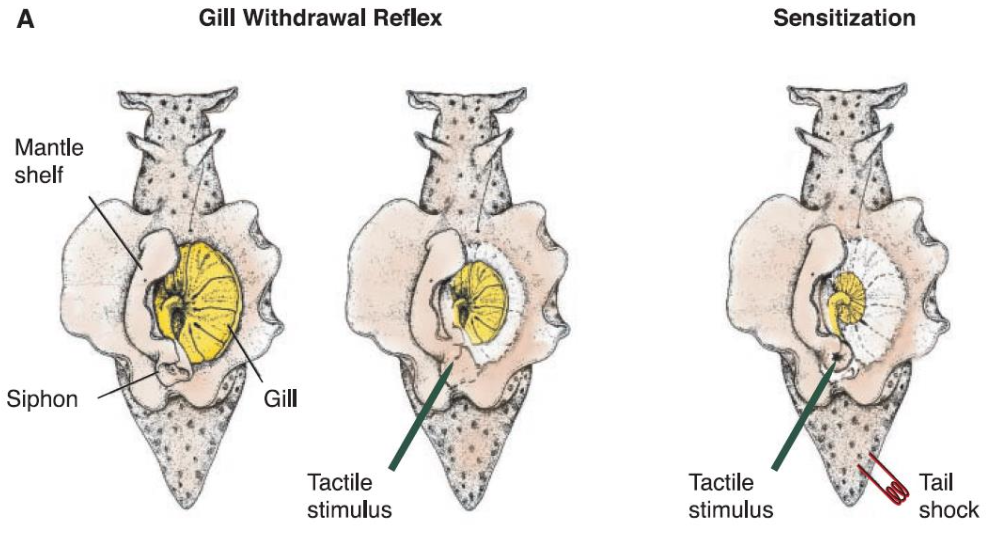
결과
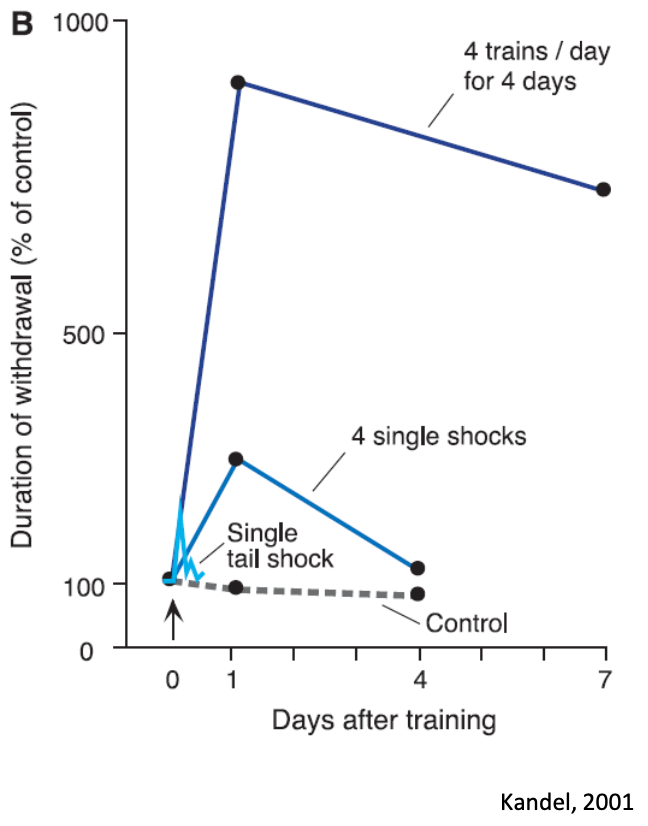
생존에 좋지 않은 tail shock를 신경계가 기억하고 있음.
Origination of memories:
- Short-term memory
- transient strengthening of preexisting synaptic connections (modification of preexisting proteins)
- Activation of serotonergic modulatory neurons by the tail stimulus. => serotonin into presynaptic sensory neuron terminal.
- serotonin increases the concentration of cAMP, a signaling molecule that activates protein kinase A. (PKA)
- PKA facilitates glutamine release, which is later converted into glutamate.
- => increase in the amount of ntm (glutamate) released by the sensory neuron onto the motor neuron that controls the gill musculature.
- Long-term memory
- Persistent strengthening of synaptic connections brought about by
- Sensory neuron alteration;
- alterations in gene expression - By long-term sensitization, PKA “moves into” the nucleus and activates gene expression.
- Synthesis of new proteins made by sensory neurons.
- Growth of new synaptic connections. (an architectural modification)
- Target motor neurons
- Dendrites grow and remodel to accomodate the additional sensory input.
- Sensory neuron alteration;
- Persistent strengthening of synaptic connections brought about by
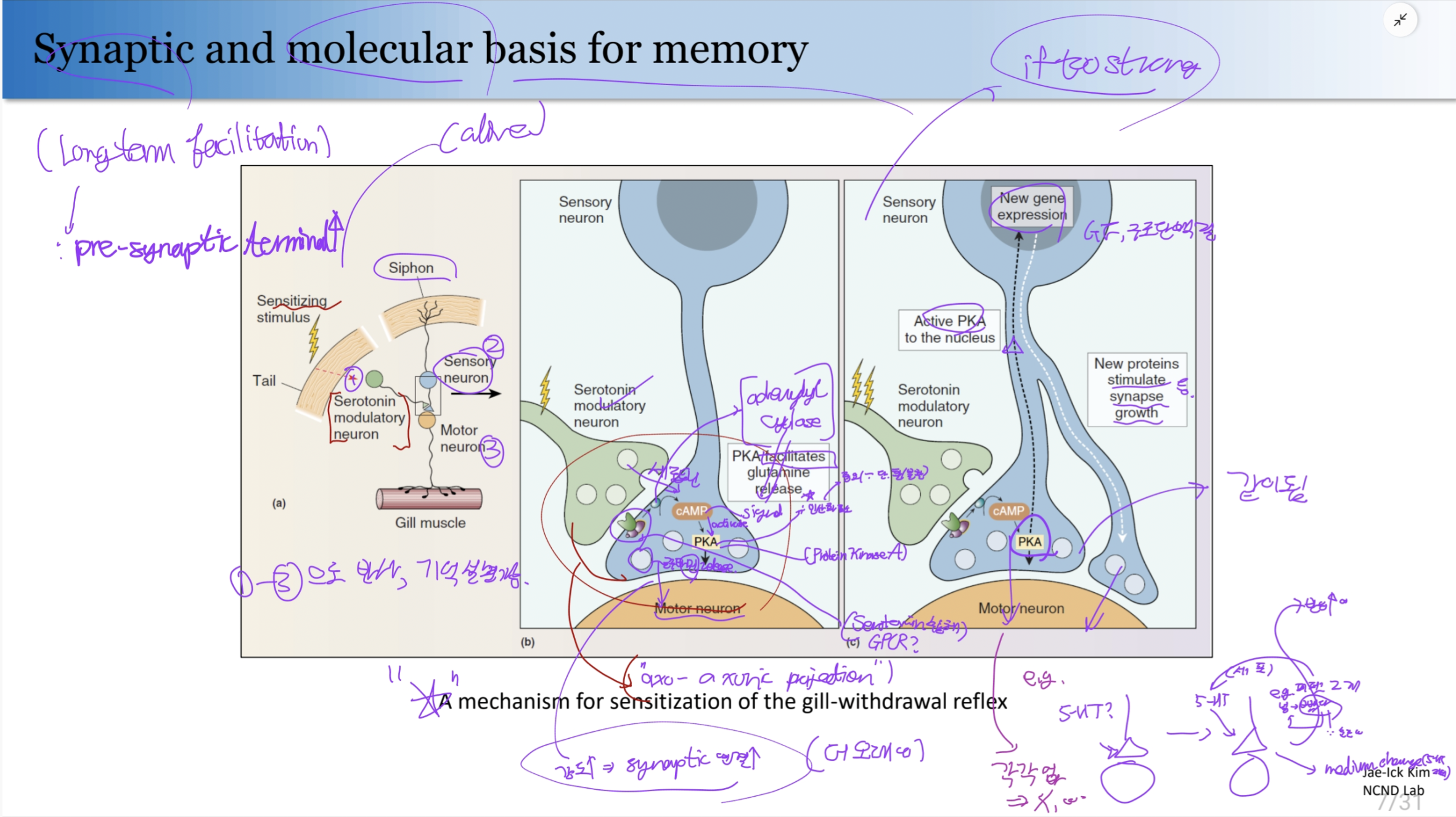
Cellular Substrates of the gill-withdrwal reflex?
1.2. Strengthening Synapses
Long-term potentiation (LTP): A long-lasting enhancement of the effectiveness of synaptic transmission that follows certain types of conditioning stimulation. (대충 base 전위 자체가 높아져서 더 잘 AP가 발생하는 그런 거?)
1.2.1. Anatomy of the Hippocampus
Hippocampus, 즉 해마는 단면이 롤케익처럼 생겼다. 실제로 강의자료로 롤케익을 넣을까 고민했다고 한다.
어떤 연결이 이루어져 있는지를 나타내는 이 diagram을 보자.
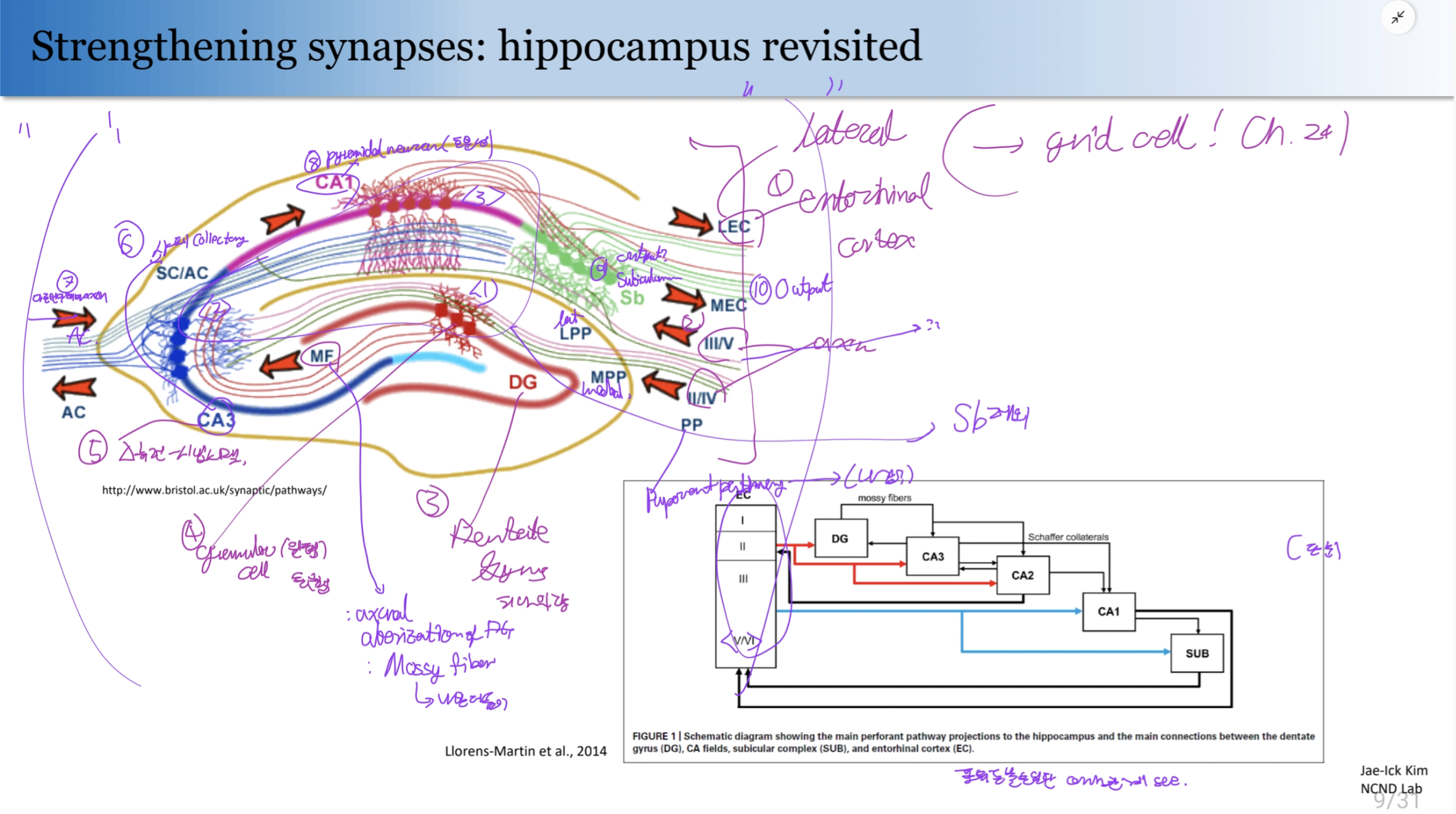
여기서 우리가 눈여겨 볼것은 저 DG, (Dentate Gyrus (i.e. Ammon’s horn)), CA1(cornu Ammonis), CA3이다.
그중 우리가 볼 연결인 trisynaptic circuit은 다음과 같이 이루어진다고 한다:
- (Input:) Entorhinal cortex -> Dentate Gyrus ((via) Perforant Path) synapses
- DG(‘s Granule cells) emit axons (=mossy fibers) that synapse upon pyramidal neurons(=> excitatory) of the CA3.
- Axons from the CA3 neurons (Schaffer collaterals) synapse upon pyramidal neurons in area CA1.
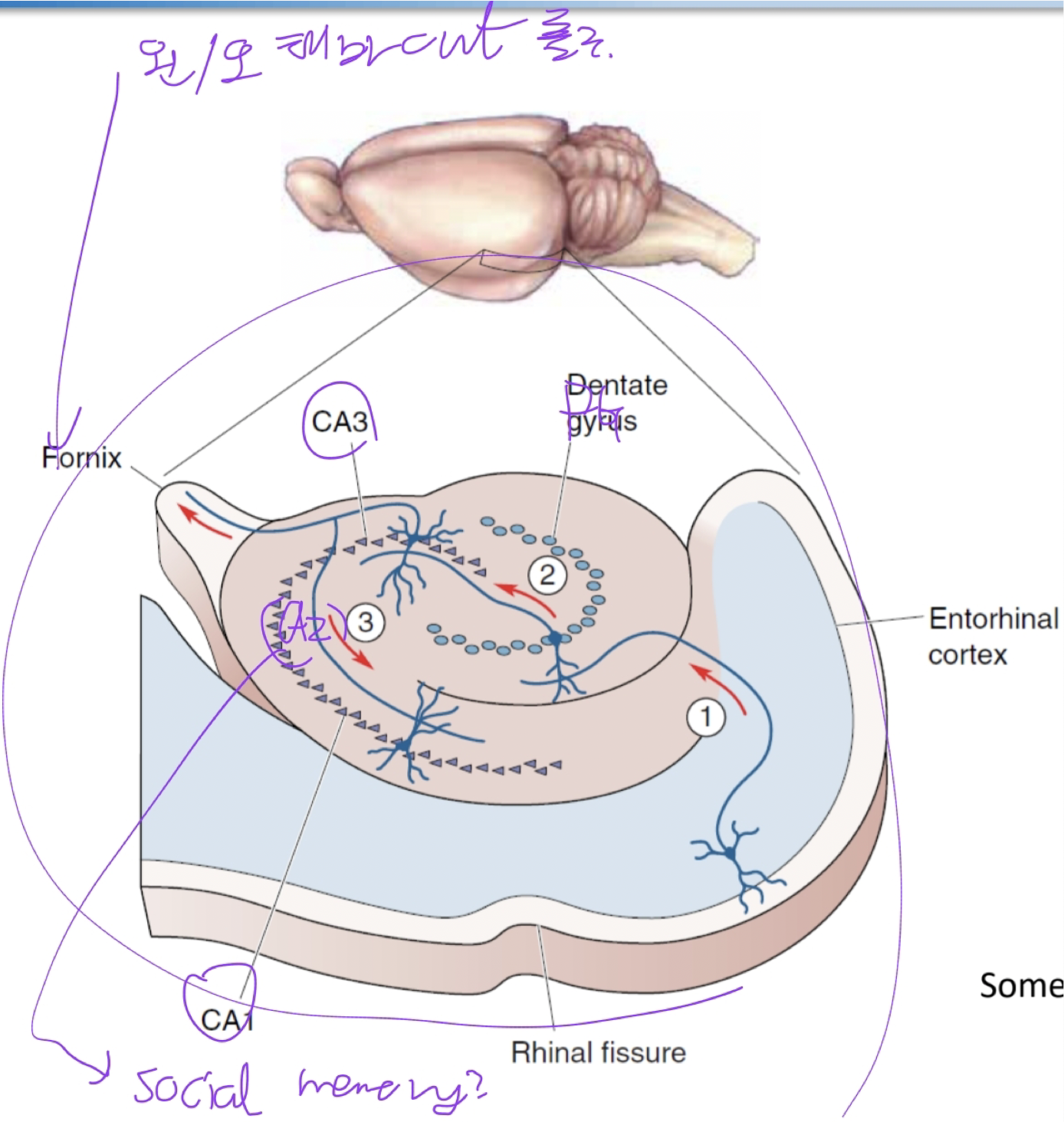
Brain slice preparation of the hippocampus가 가능한 것이 이런 것을 촉진했다.
1.2.2. Properties of LTP in CA1
실험
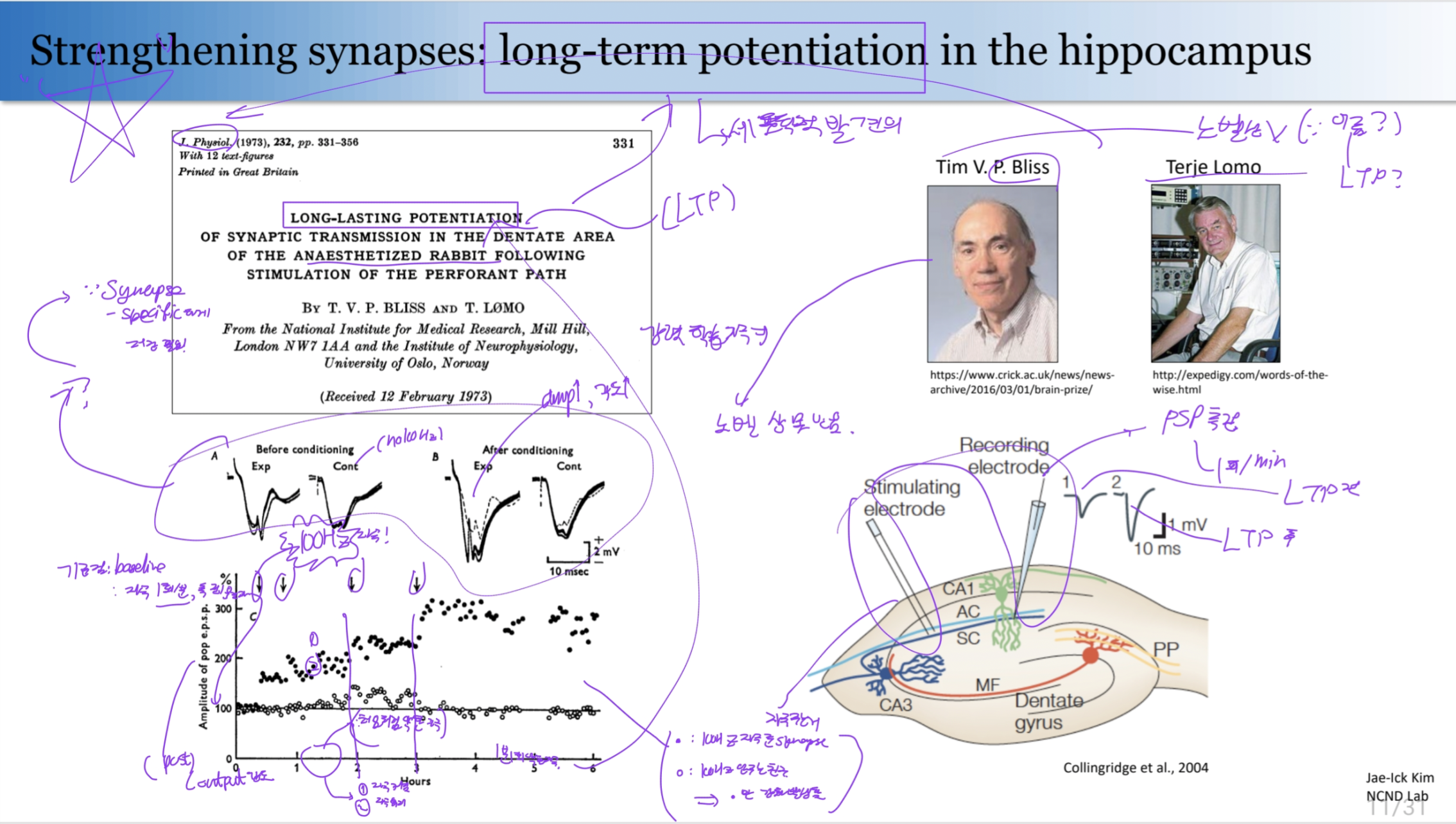
tetanus: A brief burst of high-frequency stimulation (50-100 stimuli @ 100Hz)
Given: Perforant path (or CA1 input neuron) stimulation. Give a tetanus to input 1 after baseline recording, but not to input 2. Measure: Responses of the Schaffer collaterals of the CA1 neuron given after each and every two inputs. (Input 1, 2) Baseline: Responses given 1회/분 자극, for 15-30분 (for ensuring the stability of baseline), 측정 1회/분. Result: 다음과 같다.
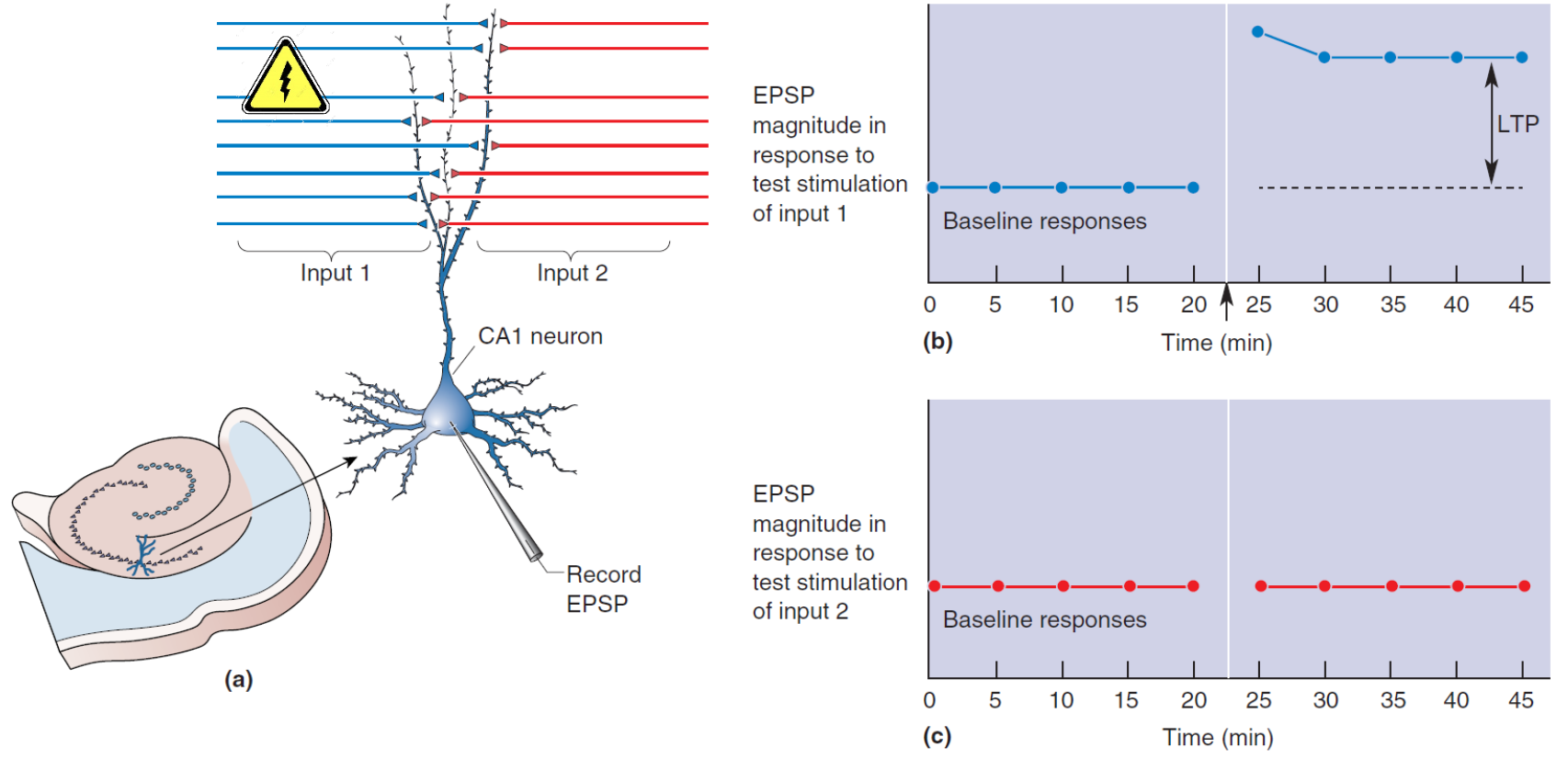
An LTP could even last for a year.
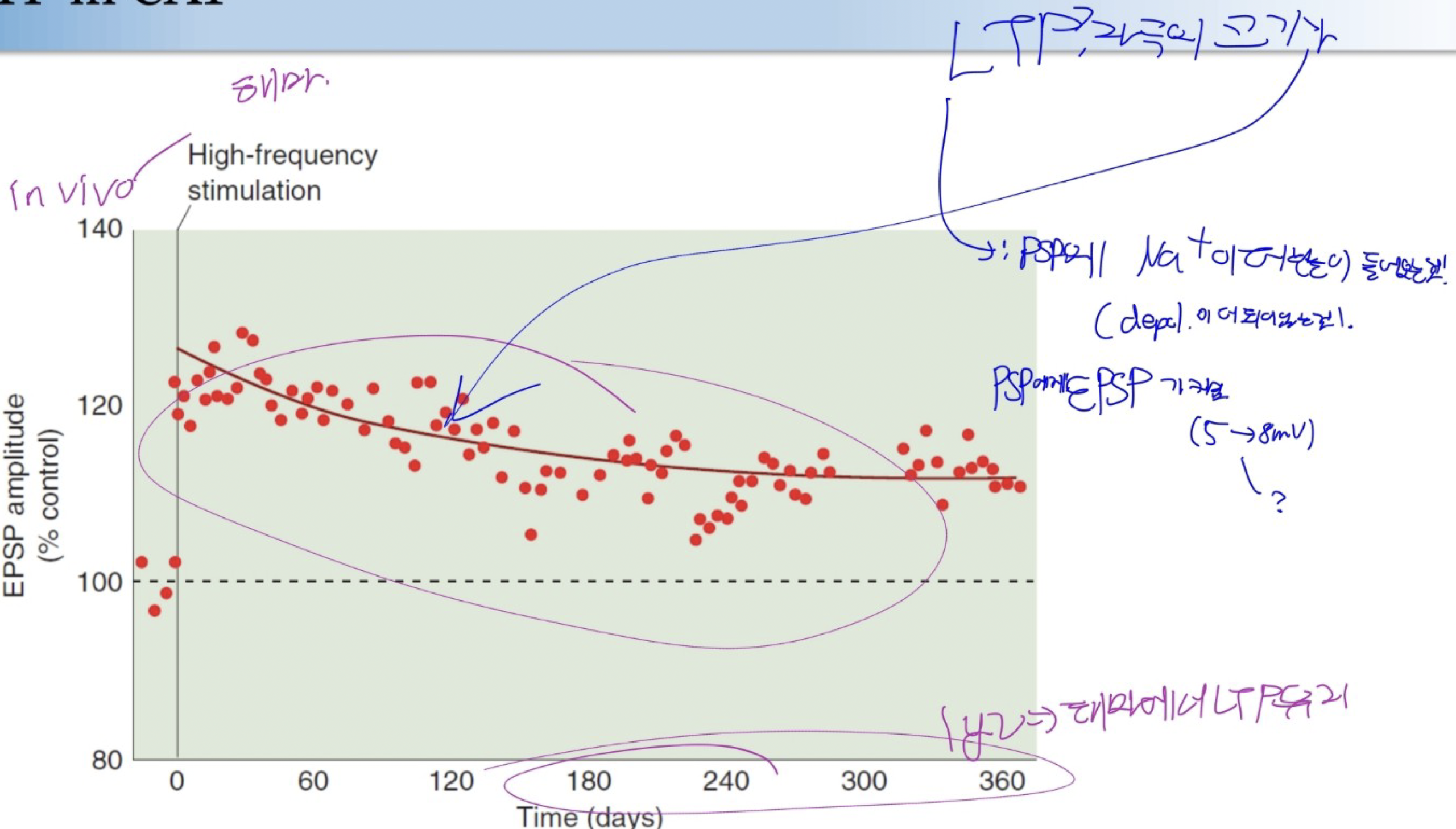
Result:
- input1: potentiated response to stimulation
- input2: no change from the baseline after a tetanus to input 1.
3 Properties of LTP
-
- Input specificity: Only the active inputs show the synaptic plasticity
- LTP는 강력한 자극을 받은 synapse에서만 일어난다. (같은 뉴런이라도 다른 시냅스의 경우 일어나지 않는다.) e.g. tetanus to input 1 yielded a potentiated graph to stimulation of the input, whereas the response to input 2 showed no change after a tetanus to input 1.
-
- Cooperativity (summation of EPSP)
- LTP require multiple activation of synapses with temporal (and spatial..?) proximity. LTP cannot result by just one synapse activation, even with the tetanus.
-
- Associativity (spatial summation of EPSP): Inputs that fire together wire together
- Weak stimulation of a single pathway, which is insufficient to induce LTP, can lead to potentiation when it occurs in conjunction with stimulus of another pathway that result in sum, enough EPSP to fire the postsynaptic neuron and to cause LTP.
e.g. Imagine a hippocampal neuron receiving synaptic inputs from three sources: 1, 2, 3. Initially, no single input is strong enough to trigger AP in the Post Synaptic neuron. Imagine that inputs 1 and 2 repeatedly fire at the same time. => spatial summation of EPSP enable the firing of postsynaptic neuron and causing LTP.
=> either input 1 or 2 can now fire the postsynaptic neuron, but not neuron 3.
demo: sight of a duck could be associated with the quack of a duck (they often occur at the same time), but not with the bark of a dog.
1.2.3. Mechanisms of LTP in CA1
Recall the postsynaptic AMPA and NMDA receptors of glutamate:
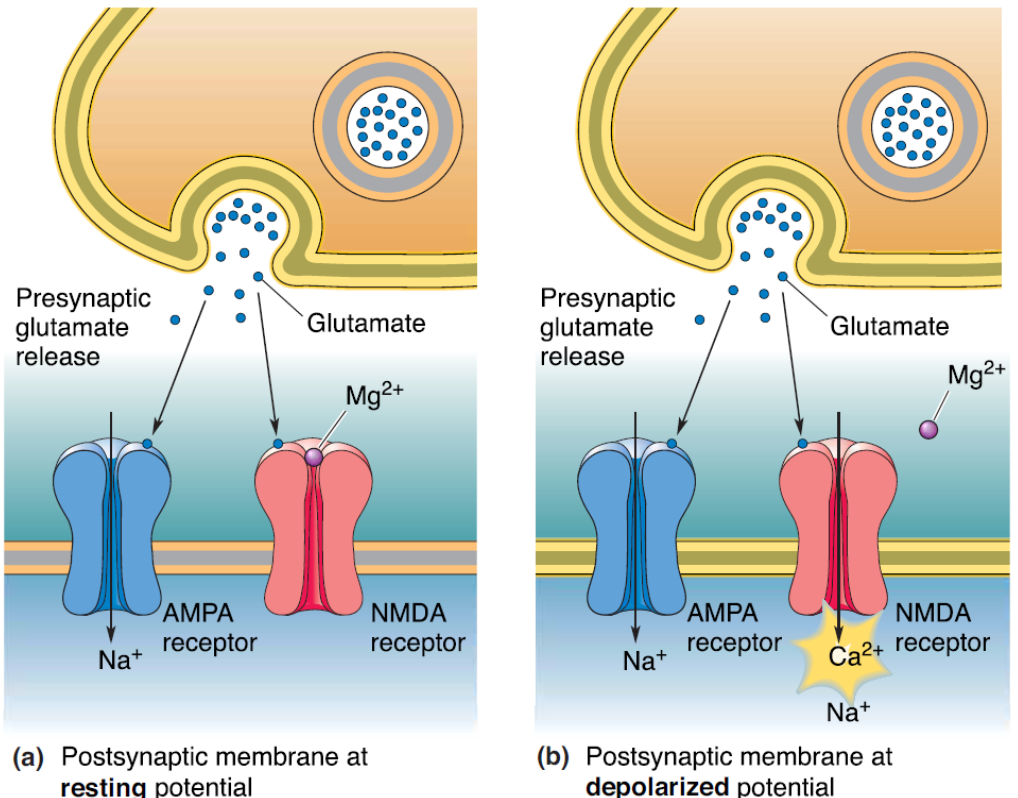
- AMPA receptor
- Open: glutamate binding
- Result: dissipate Na+ from into the cell, causing a depolarization
- NMDA receptor
- Open:
- glutamate binding
- enough depolarization (e.g. by AMPA opening) => remove the clogging Mg2+
- Result:
- Dissipate Na+ into the cell.
- Dissipate also Ca2+ into the cell. (This Ca2+ plays many many roles in the cell.)
- Open:
[N]: Ca2+ entry through the NMDA_R specifically signals when presynaptic and postsynaptic elements are active at the same time!
Various evidence now links this rise in internal postsynaptic [Ca2+] to the induction of LTP.
2 cases: A structural change, and an architectural change
-
LTP가 처음 유도되는데 관여하는 molecule: Ca2+, and kinases.
- Ca2+ activates protein kinases: PKC, CaMKII (calcium-calmodulin-dependent protein kinase II (cam-K-two))
- They activate other proteins.
- 2 paths:
- non-structural changes
- Phosphorylate the existing postsynaptic AMPA receptors => increase the ionic conductance of the channel. (heighten the channel opening probability and increase duration of opening)
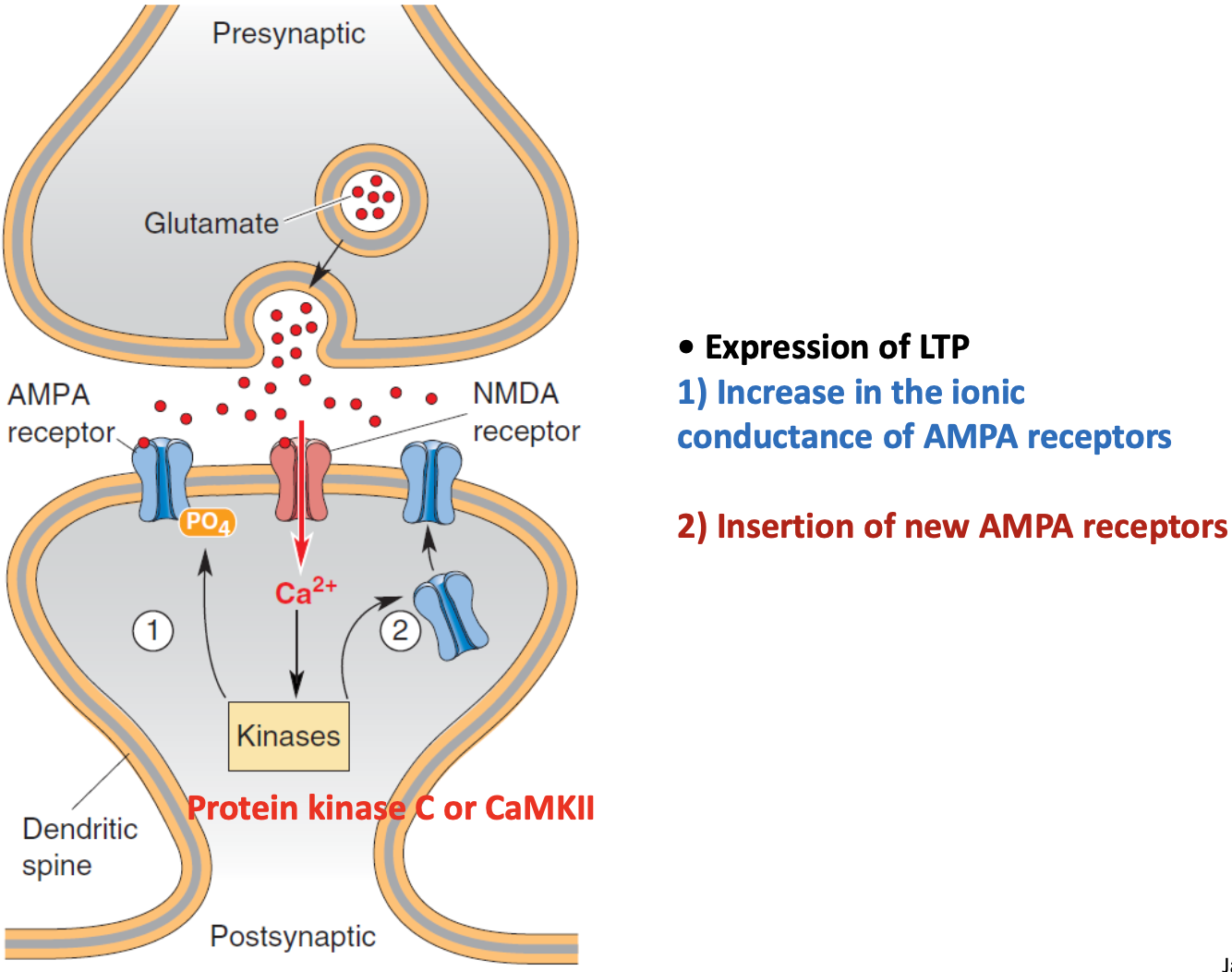
- CaMKII activation results in the vesicular organelles studded with AMPA_R to fuse with the postsynaptic membrane, increasing the number of AMPA receptors; (resulting in the swelling of spines).
- Phosphorylate the existing postsynaptic AMPA receptors => increase the ionic conductance of the channel. (heighten the channel opening probability and increase duration of opening)
- synaptic structural changes
- swelling of postsynaptic dendritic spine head.
- 이런 molecule을 들고 오고, 노란 빛에 레이저를 쏴서 선택적으로 glutamate를 dendrite 근처에 고농도로 만들었다.
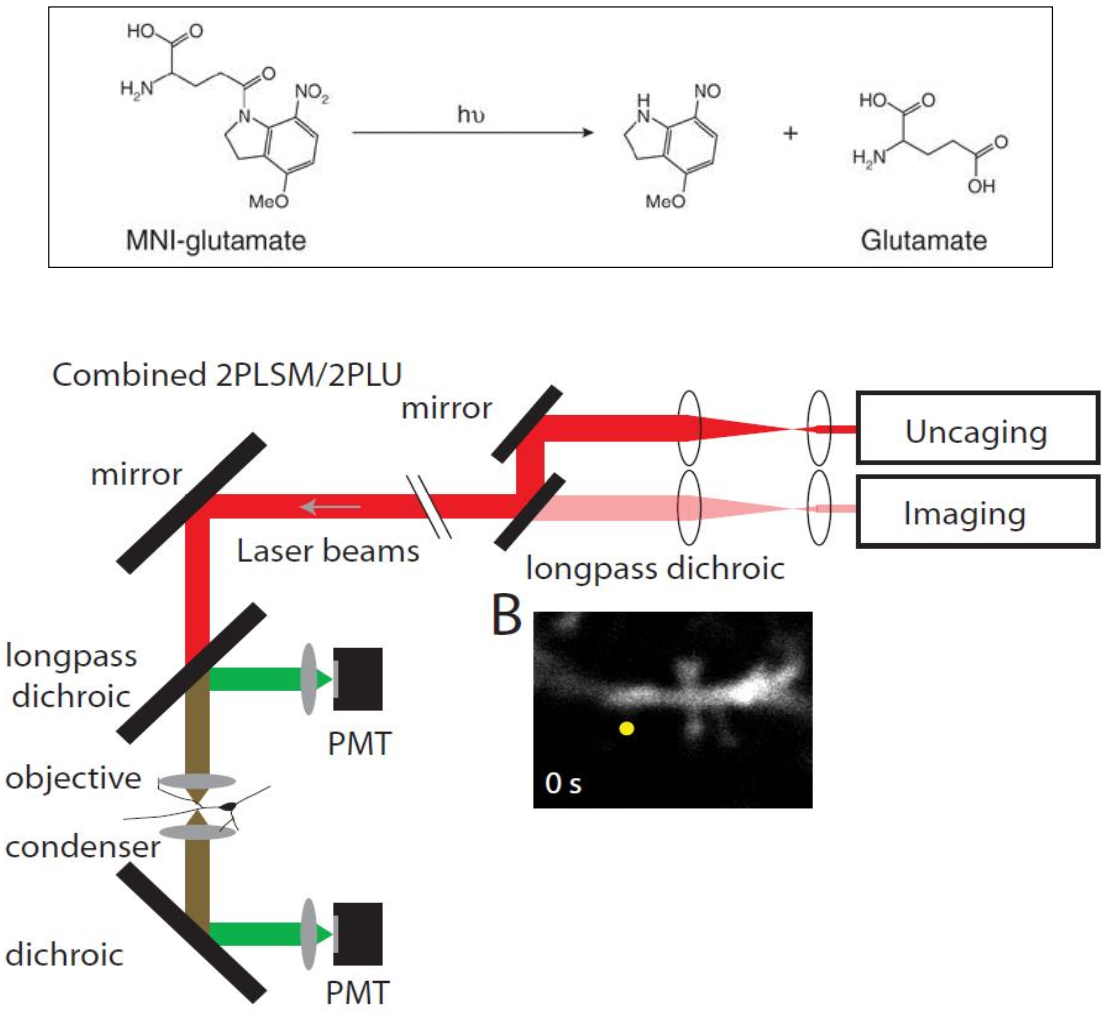
- 그쪽에 새로운 spine이 자라거나 커졌다. => single axon forming multiple synapses on the same postsynaptic neuron. (abnormal in CA1) =>
- Increase the responsive postsynaptic surface and
- Increase the P() that an AP in the axon will trigger presynaptic glutamate release.

- 이런 molecule을 들고 오고, 노란 빛에 레이저를 쏴서 선택적으로 glutamate를 dendrite 근처에 고농도로 만들었다.
- swelling of postsynaptic dendritic spine head.
- non-structural changes
1.3. Weakening Synapses
BCM theory: up and down regulation of synaptic strength is possible. (i.e. A theory proposing tha synapses are bidirectionally modifiable.)
- LTD: Long-Term Depression
-
A long-lasting decrease in the effectiveness of synaptic transmission that follows certain types of conditioning stimulation.
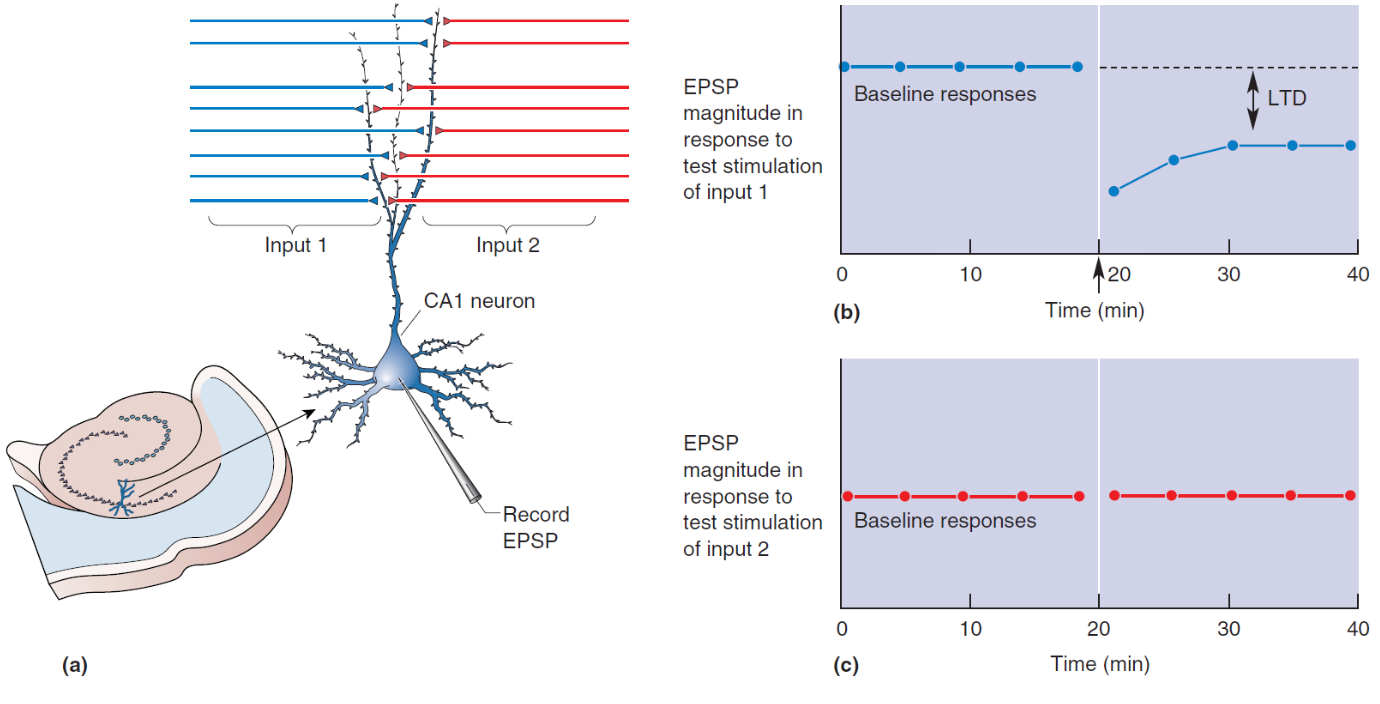
“말 기억!”
cf. spike timing-dependent plasticity
1.3.1. Mechanisms of LTD in CA1

G-protein coupled metabotropic glutamate receptors: mGluRs. - NMDA receptor-dependent LTD how happen?
=> 저주파수 자극을 통해. ㅇㅇ
1.3.2. Glutamate Receptor Trafficking
1.4. LTP, LTD, and Memory
1.5. Synaptic Homeostasis
Recall homeostasis: regulatory process within a useful dynamic range.
Synaptic Homeostasis:

.png)